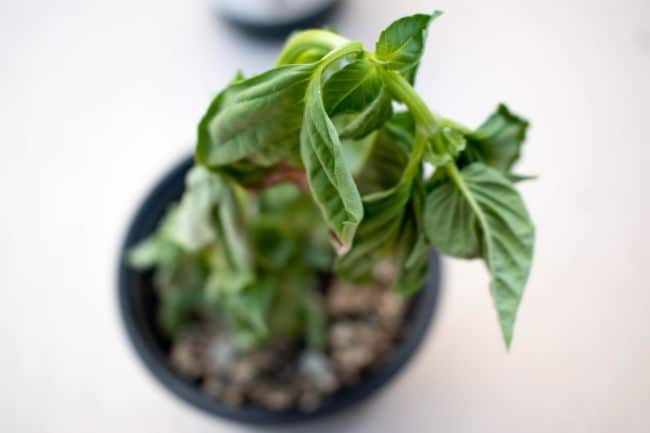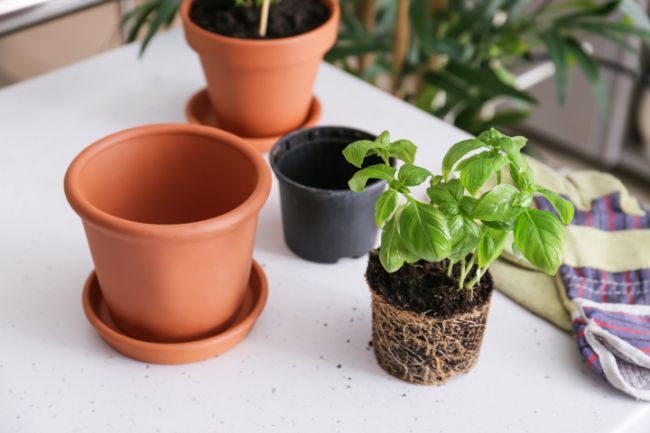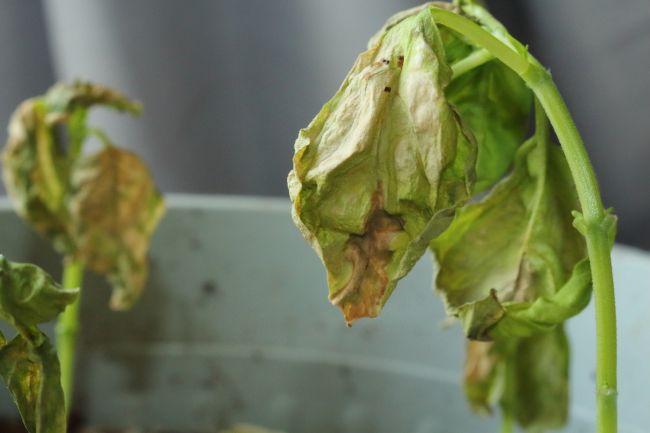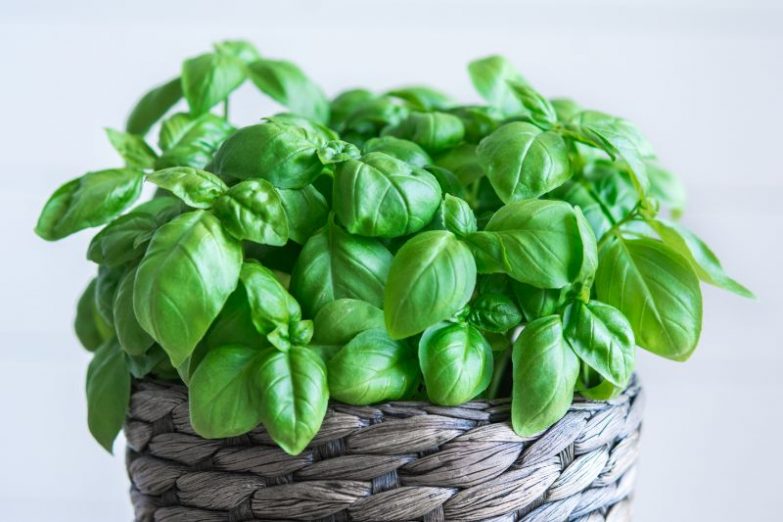Basil is a popular and aromatic herb, used widely in food preparation, but can also be attractive in the garden. It’s a sensitive plant but is relatively easy to take care of if you’re armed with basic Basil care knowledge. If you’ve found your Basil leaves turning brown, this article will help you identify the problem and get your plant thriving again
The most common causes of Basil leaves turning brown are under or over-watering, temperature stress, insufficient lighting, pests, or diseases. Brown leaves on Basil is usually a sign of a problem with the plant’s health and should be addressed as soon as possible.
In this article, we’ll consider the best way to plant and maintain Basil. We’ll look at the various triggers that can cause Basil leaves to turn brown and suggest ways to deal with each of these.
Basil Plants (Ocimum Basilicum)
Basil is an aromatic herb that is used both fresh and dried and has been in the historical record at least 2000 years. Its Latin name is Ocimum Basilicum – Ocimum originates from the Greek word okimon, meaning “smell,” and Basillicum is the Latin form of a Greek word for a “kingly ointment” or “kingly herb.” There are 35 different Basil species and numerous cultivated varieties (source).
Growing Basil In Your Garden
Basil is an annual that is easy to grow in a home garden. It flourishes best in full sun and well-drained soil. Ideally, seeds should be germinated indoors between 65-75 °F (18-24 °C) and transplanted outdoors in spring, once the threat of frost has passed.
When transplanting outdoors, seedlings should have at least three pairs of leaves and be spaced about a foot apart in garden beds. When flowers appear, you should cut the plant back to six inches.
Many people just nip the flowers, but this tends to stimulate more flowers rather than vegetative growth. Outdoor basil plants require the following:
- Six hours of sun per day
- Nighttime temperature above 60°F
- An inch of water per week
- Cut stems to harvest – do not pull leaves
- Propagate using seeds or cuttings
Growing Basil In Pots
Basil can be successfully grown indoors in pots, provided the soil is not allowed to become soggy. Pots must have a drainage hole to prevent this from happening.
Potting soil should be fresh and spongy, and plants should be watered sparingly – don’t water if the soil feels moist. Indoor Basil plants also require at least six hours of direct sunlight a day, so you can place them on a sunny windowsill.
I like to regularly propagate my Basil plants, to maintain a steady supply of fresh basil all year round. I’ve written a step by step guide to propagating Basil plants that you may find useful.
Causes Of Basil Leaves Turning Brown
Basil is a rewarding plant because it looks attractive and can be used fresh in numerous dishes or dried for later use. It’s not a high-maintenance plant, but it is quite susceptible to imperfect conditions and, at the first sign of trouble, its leaves can turn brown.
This is true of many plants where brown leaves can indicate a problem. There are many reasons why Basil leaves turn brown, which we’ll discuss in greater detail below.
Underwatering
Like any plant, basil needs water to survive. If the plant is left until the soil dries out, then it will suffer, and the leaves will begin to curl, shrink, and turn brown. Especially if the plant is receiving a lot of sun, such as on a hot windowsill, it needs sufficient water to keep the soil moist.
The leaves of a Basil plant that is underwatered will often become bitter and unpleasantly pungent.
Don’t water your Basil plant on a schedule, but check the soil and foliage every few days to see if it needs to be watered. The plant can tolerate underwatering for a limited time and can recover if watered soon enough. However, if there has been severe damage due to underwatering, it can sometimes be impossible to save the plant.

Overwatering
Too much water is a common mistake made by owners of Basil plants. Overwatering a Basil plant will cause the roots to rot and the leaves to turn yellow and then brown. The soil should be moist but not soggy. This can especially be a problem if you have planted Basil in a pot without a drainage hole.
Overwatering happens most often with indoor plants because there is less evaporation of moisture indoors. Overwatered basil will first start wilting, and the leaves will then start changing color.
If you suspect you may have overwatered your basil, the first place to check is the roots. If they are soft, mushy, and brown in color, then they are rotting.
If the damage is minimal, you can save the plant by replanting it in new soil and only watering when the soil is dry to the touch. If the roots have entirely rotted, then the plant cannot be salvaged.
Sunlight Issues
Basil likes sun and requires six to eight hours of either full or partial sunlight daily. It can survive with four hours of direct sunlight if other conditions are optimal. Basil grown indoors, out of natural light, will need up to 12 hours of artificial light per day.
Indoor Basil grown in the Northern hemisphere should ideally be on a south-facing windowsill, while outdoor Basil should be planted in full sun. Lack of sun will cause the plant’s leaves to curl and turn yellow. It will also result in a plant with long stems and fewer leaves (source).
You can easily remedy this by moving the plant to a sunnier position or, if that is not possible, purchasing grow lights that mimic these light conditions can work well.
Very young Basil plants can suffer from too much sun, but mature plants generally thrive in sunlight. That said, if you live in an extremely hot climate, your plant may be happy with some afternoon sunlight.
Becoming Root Bound
If your container is too small, this may cause the leaves to discolor. A Basil plant has a large root system that needs space and, if they are cramped, they could end up suffocating themselves by growing in circles. When this happens, the plant is referred to as being “rootbound.”
Signs of becoming rootbound include roots growing extensively out of the drainage holes, or the soil drying out very rapidly after being watered. If this is an issue for your plant and you realize it in time, you can repot it into a larger pot.
Gently remove your Basil plant from its existing pot and repot into a larger container. There is no need to loosen the roots excessively, as this will often do more harm than good. New roots will soon grow into the expanded volume of soil in the new pot.

Temperature Changes
Basil is sensitive to abnormal changes in temperature, especially extreme cold, frost, or drafts. Intermittent or prolonged exposure to cold can result in Basil leaves turning brown, new leaves may be deformed, or growth may be halted.
As an herb traditionally grown in tropical climates, basil doesn’t tolerate cold well and will suffer if its environment drops below 50°F. Basil will also react poorly if nighttime temperatures drop too drastically.
You can salvage a plant exposed to cold if you move it timeously to a new environment and plant it in warm soil.
Pests
Although Basil is a fairly hardy plant, there are certain insects that can attack it. These include aphids, spider mites, thrips, and scales, which all suck the plant’s juices and cause its leaves to turn brown.
You should inspect your plants on a regular basis to look for pests. carefully examine both sides of the leaves and along the stems. Leaves may develop yellow spots in an irregular pattern, or entire leaves may turn brown or yellow.
Gardeners can treat these by either spraying the plant with insecticidal oils or soaps or by making use of predatory insects such as ladybugs or wasps that will rid the plant of the offensive insects. I’ve written an article covering how to identify, treat, and prevent common plant pests.
Disease
Basil can suffer from fusarium or verticillium wilt, or damping off. These fungal diseases that will result in Basil leaves turning brown. You can treat damping-off with fungicide, but fusarium and verticillium wilt are unfortunately lethal for the plant and cannot be treated (source).
The best approach to disease is prevention and to avoid overwatering. An overly damp environment encourages fungal growth and should, therefore, be avoided. Plants also need sufficient space between them to encourage airflow.
If your plant is suffering from fusarium or verticillium wilt, you should dispose of it immediately, and you should ensure that it doesn’t infect neighboring plants.

Stress
Basil reacts badly to overhandling. Excessive replanting can cause the plant to experience shock, which will result in stunted growth and wilting, brown, or yellow leaves.
Planters should allow newly transplanted Basil to get used to its new environment without too much water or any drastic changes in temperature or environment. You should be careful not to change pots too often as this can lead to the death of the plant.
Final Thoughts
For a hardy plant that grows all over the world, it is surprising how sensitive Basil can be. However, it shows off its discomfort with discolored, curling, or wilting leaves and allows its owners the opportunity to remedy the situation.
It’s important to know how much sunlight, water, and care your plant needs so that you can keep it as healthy as possible. Reacting to problems quickly will allow you to enjoy a healthy and productive plant.
If you need more help getting your Basil plant back to perfect health, I’ve written another article about how to fix the most common Basil plant problems.

